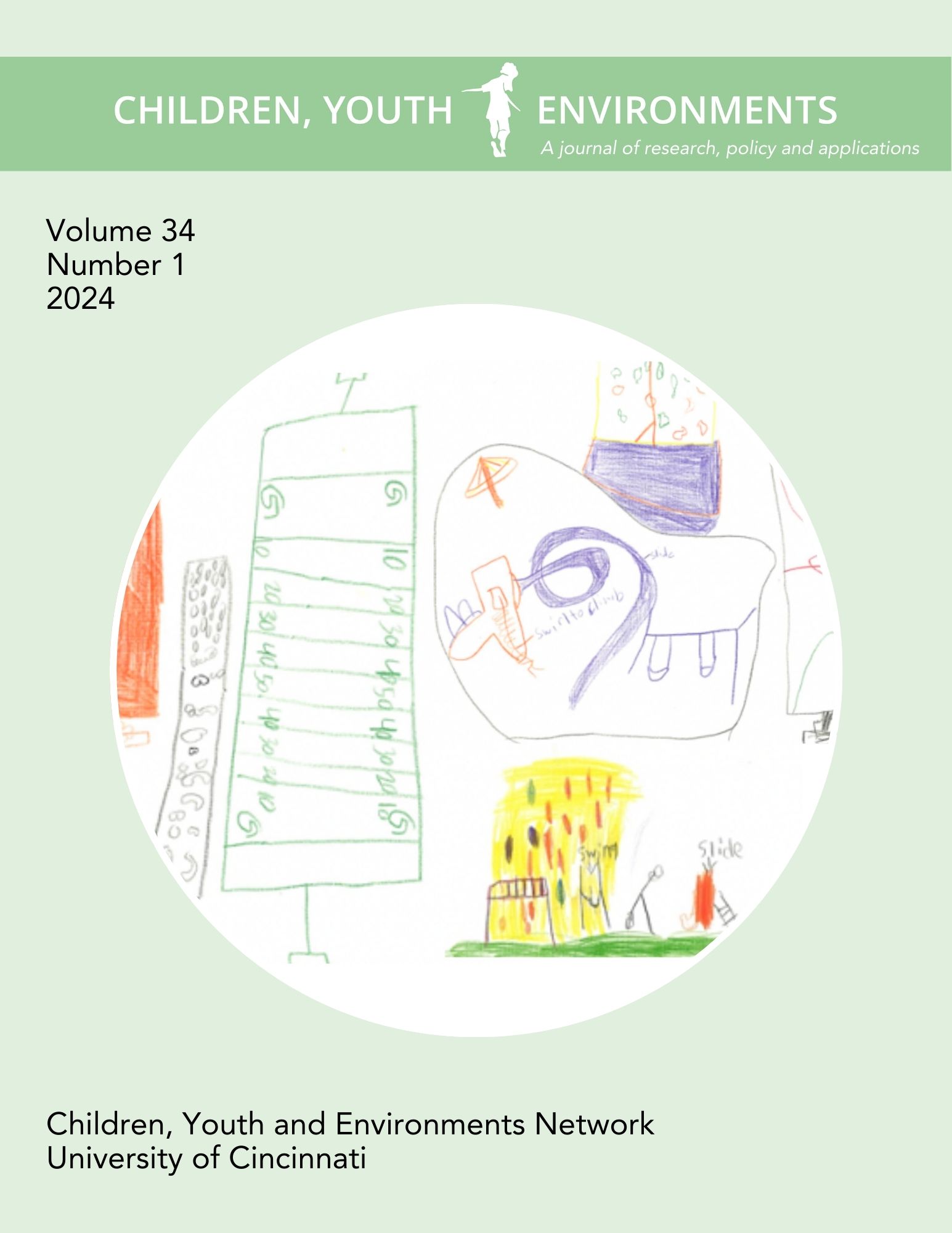Archives
-

Children, Youth and Environments
Vol. 35 No. 1 (2025)Inside this issue, you will find diverse scholarly work that spans across the globe. We first arrive in the midwestern region of the United States where Underwood and coauthors interviewed teachers to explore how nature preschools foster empathy development in young children. By focusing on teachers' experiences, they were able to create a conceptual model highlighting the role of the natural environment, school culture, and teachers in nurturing empathy in children. Next, Jones analyzed participant-created digital stories and interviews about garden programs at U.S. secondary schools to evaluate themes in environment, instruction, assessment, and professional learning. Findings revealed there are common themes like building relationships and student leadership and suggested that stakeholders could benefit from garden-based education resources focused on justice and cultural sustainability. Heading west to Texas, Trina and coauthors studied a nature-based preschool in Texas to test if outdoor environments with appropriate landscape elements encourage STEAM-related behaviors in children aged 3-5. They found that children engage in more STEAM activities in settings with flexible features like sand and water play areas, loose parts, and varied natural topography. Staying in Texas, Guerrero and co-authors conducted an online survey of early childhood educators to explore their views on outdoor play settings and their design features that various forms of play. The analysis of quantitative and qualitative data informs practical implications for architects and early childhood centers to design environments that intentionally foster these types of play. Heading back east, Moore and coauthors examined horse camp experiences of historically underserved youth (ages 9-18) through letters written to their assigned horses and interviews with riding instructors. The analyses revealed that the program helped participants develop positive relationship skills such as respect, responsibility, discipline, and social connections, providing valuable opportunities for socio-emotional growth through interactions with horses. Spanning across the United States, Iwinski and coauthors analyzed data from 468 families in a longitudinal birth cohort study and found that early access to green space and outdoor items positively influences children's cognitive development and household environment. They emphasized the importance of promoting green spaces and reducing household chaos to support executive function and well-being, with implications for education and policy.
The issue continues with two reports from the field. First, Derr and coauthors describe a partnership between a land trust, elementary school, and university in California, focused on fostering empathic relationships for children with limited access to nature. Using an action research framework, the partnership co-creates, co-learns, and documents "magical moments" of joy and connection with the land and each other. Next, Reyes and share an initiative in Santa Ana Chiautempan, Mexico, where "play yards" were created to promote free play and recover public space for recreation. The evaluation, based on surveys and field observations, showed the initiative's positive impact on children's holistic development.
We wrap this issue with two book reviews: Thueneman’s review of The Extended Mind: The Power of Thinking Outside the Brain by Annie Murphy Paul and Wilson’s review of The Nature of Inclusive Play by Amy Wagenfeld and Chad Kennedy.
Happy reading!
-

Children, Youth and Environments
Vol. 34 No. 2 (2024)Inside this issue, you will find diverse scholarly work that spans across the globe. We first arrive in Singapore where Seow and coauthors explore the application of Design-Based Implementation Research (DBIR) and conjecture mapping to address challenges in youth program design, such as unclear outcomes, contextual adaptability, and sustainability. They found that by focusing on targeted outcomes, contextual considerations, and stakeholder experiences, the DBIR approach offers a promising solution to enhance youth program design. Next, we venture to Belgium where Coomans and coauthors examine how the built environment influences children’s experiences at a child psychiatric center all while highlighting the importance of spatial design in mental health care. Interviews revealed that children view the organically shaped building as a secure base, appreciating areas where security and autonomy are balanced, with preferences varying among individuals. Heading across the Atlantic, O’Connor and Pavkov studied programs throughout the United States (US) to show that natural environments are ideal for developing critical childhood skills, influencing the creation of therapeutic nature-based programs. Focus group interviews with practitioners highlight that these programs effectively support orientation to others and the environment, sense of self, self regulation, and sensory integration skills, with future assessments needed to further validate these findings.
Narrowing our scope to the midwestern region of the United States, Stanton-Chapman and Nabors analyze the impact of a universally designed playground on grandparents and their grandchildren, based on surveys and short answer responses from 28 grandparents. Findings indicate that while grandparents frequently visited the playground and engaged in various activities with their grandchildren, physical limitations prevented them from using certain equipment; however, the universally designed playground encouraged play and behavior management, suggesting benefits for community health and safety. The issue continues with a report from the field by Howarth and Miller highlighting the experiences of two coaches and ten high school students exploring Dry Creek’s ecology, emphasizing the concept of land as a teacher and gift-giver. It highlights the importance of value-shifting education to address climate change, advocating for learning conditions such as humility, community, and freedom to foster a relational understanding with the natural world and promote reciprocal relationships with the Earth.
Happy reading!
-
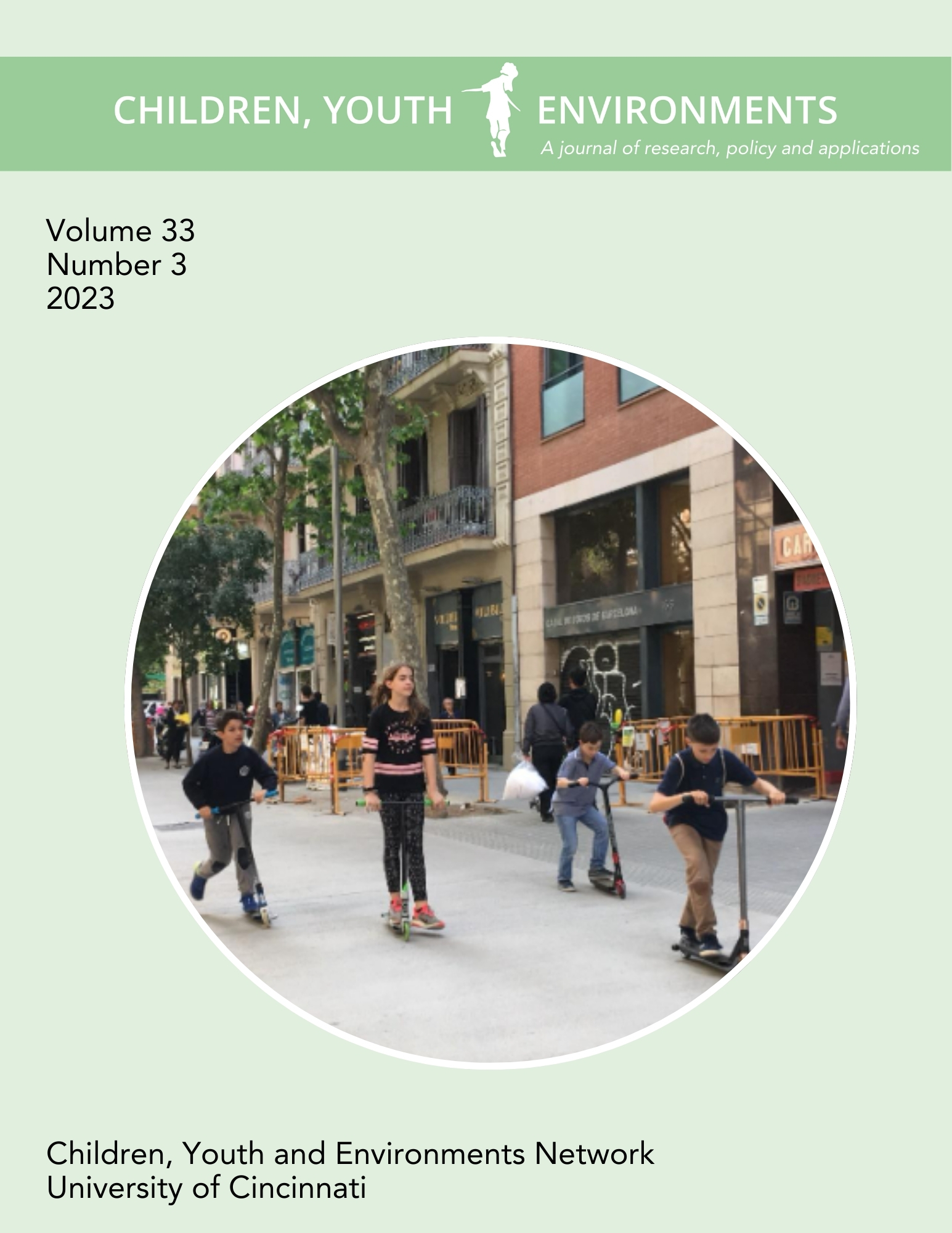
Children, Youth and Environments
Vol. 33 No. 3 (2023)Inside this issue, you will find diverse scholarly work spanning across the globe. We start a thorough review of the Child-Friendly Cities Initiative across 24 countries spanning the last 30 years. Chatterjee navigates common criticisms to the initiative to demonstrate how this work has promoted public spaces for children. Next, we head to Honolulu, Hawai’i where Kong and colleagues explore the connection between place-based cultural education and well-being among Native Hawaiian youth as they engage in restoring a royal Native Hawaiian fishpond. In California, Derr and coauthors investigated how sustainability practices take shape and unfold in historically excluded schools who have won sustainability awards to reveal three domains of a sustainability-in-place model. Heading inland to cover the United States and Canada, Meltzer and coauthors investigated factors related to teenagers’ loneliness during the COVID-19 pandemic. Findings suggest potential policies to help teens during similar crises. Returning to California, Minaravesh and coauthors investigated the development of fourth grader children’s environmental attitudes in the South Bay Region, a historically environmentally disadvantaged neighborhood that are rarely heard from in these types of studies. Findings from focus group data suggests children conveyed positive eco-perspectives despite unfavorable local conditions. Then we make our way east across the globe to Vienna, where Stark and coauthors conducted a case study connecting the influence of redesigning the infrastructure surrounding an elementary school on students’ mobility behavior. The issue continues with a report from the field in Thailand where Nunma and Kanki analyzed the Foundation of Child Development’s strategic mural creation to show how they facilitated child-centric activities in vibrant play spaces. We close our issue with two book reviews: Ellinger’s review of High-Quality Outdoor Learning: Evidence-based Education Outside the Classroom for Children, Teachers and Society, edited by Rolf Jucker and Jakob von Au, and Gull’s review of Naturally Inclusive: Engaging Children of All Abilities Outdoors, by Ruth Wilson. Happy Reading!
-
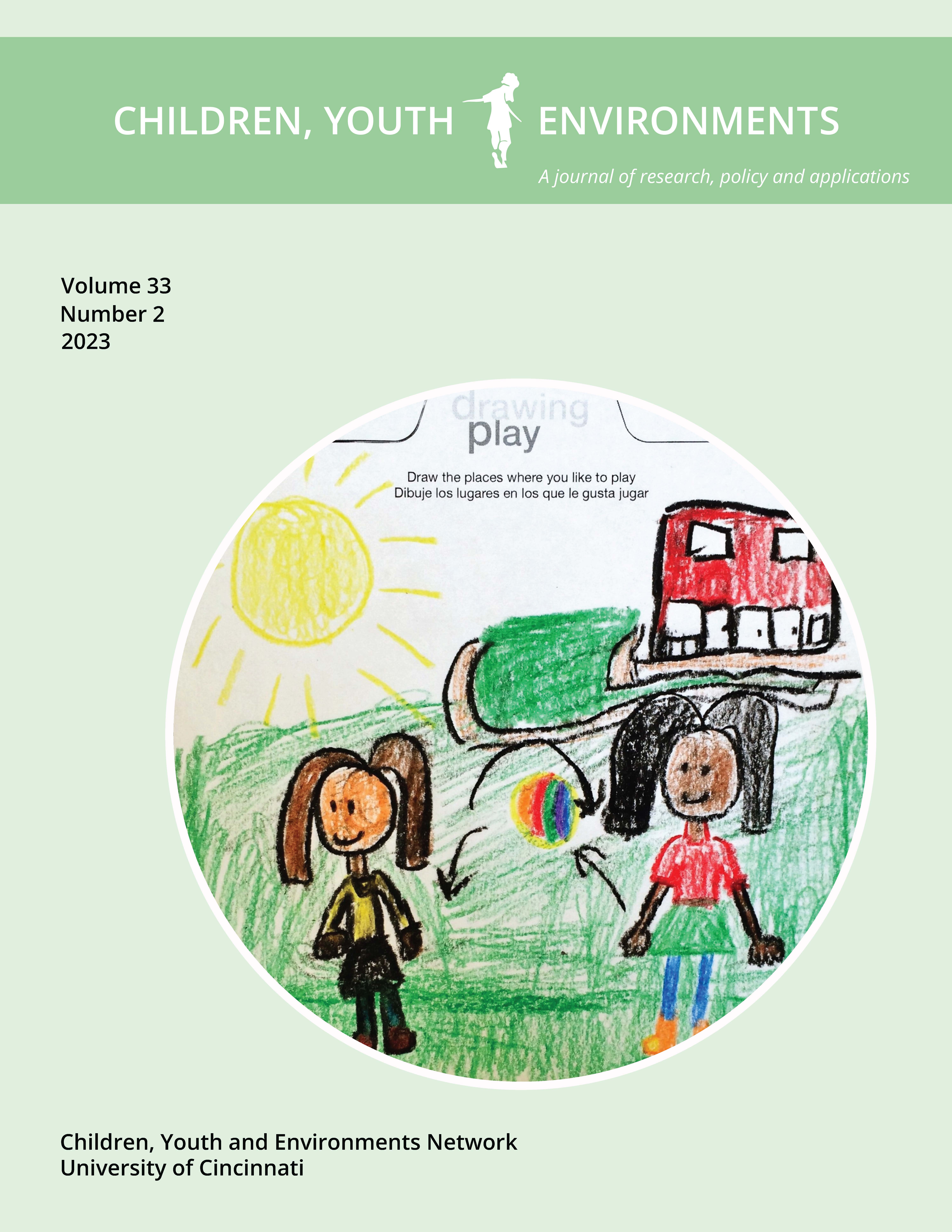
Children, Youth and Environments
Vol. 33 No. 2 (2023)Inside this issue, you will find diverse scholarly work spanning across the globe. We start our trip with a scoping review where Williams and colleagues identified studies where children were active participants in the design, creation, and production processes in the construction of a physical environment. Findings aided in the creation of a reporting checklist for studies including children in the “co” processes. Next, we head to Denmark where Christensen and Simovska qualitatively studied children’s wellbeing at school to reveal that school facilities, workload, rhythms, time schedules and numerous transitions all play pivotal roles in student experiences of wellbeing, as well as their ability to be involved in decision making processes at school. Heading across the Atlantic, we arrive at an urban medical clinic in the United States where Barriage and colleagues asked children to draw where they liked to play. Findings revealed that physical, outdoor environments were common elements in the drawings while playing with other children was not. Traveling south to Brazil, Macena and colleagues investigated children’s contact with nature during the COVID-19 pandemic. Findings revealed that children had frequent contact with nature during this time and suggest there was a period of (re)connection with nature.
Returning to the United States, Traub and Mainzer conducted a meta-analysis focusing on outdoor nature spaces and their impacts on students across disciplines to reveal that though there is rising diversity amongst approaches to studying holistic wellness, there continues to be gaps within the discipline for the broader conceptualization. We then cross the Atlantic to arrive in Kerman, Iran where Mani and colleagues developed a new valid and reliable measure to capture children’s perceived restorativeness in their everyday environments. Results showed that the different environments included in the study scored differently based on their size, degree of naturalness, and the available play equipment. We head back to Brazil to end our world tour where Stencel and colleagues studied rural children’s first experiences with urban elementary school spaces. Data from multiple methods revealed that rural children found the urban spaces restrictive and controlled which led to the children having a difficult time constructing new meaning for the spaces. Stencel and colleagues suggest that educators in the urban educational space should provide opportunities for children to manage certain spaces to support their development, increase satisfaction with the school environment, and ease this new transition for the children.
The issue continues with three reports from the field. First, Martz and colleagues used a qualitative GIS approach to evaluate environmental education programs. Next, Orr and colleagues share how they were able to reduce nature aversion with elementary students during environmental education programs. Lastly, Banerjee and colleagues share how their program was able to empower adolescent girls during COVID-19. We close our issue with Derr’s review of Teaching in the Anthropocene: Education in the Face of Environmental Crisis, edited by Alysha Farrell, Candy Skyhar, and Michelle Lam. Happy Reading!
-
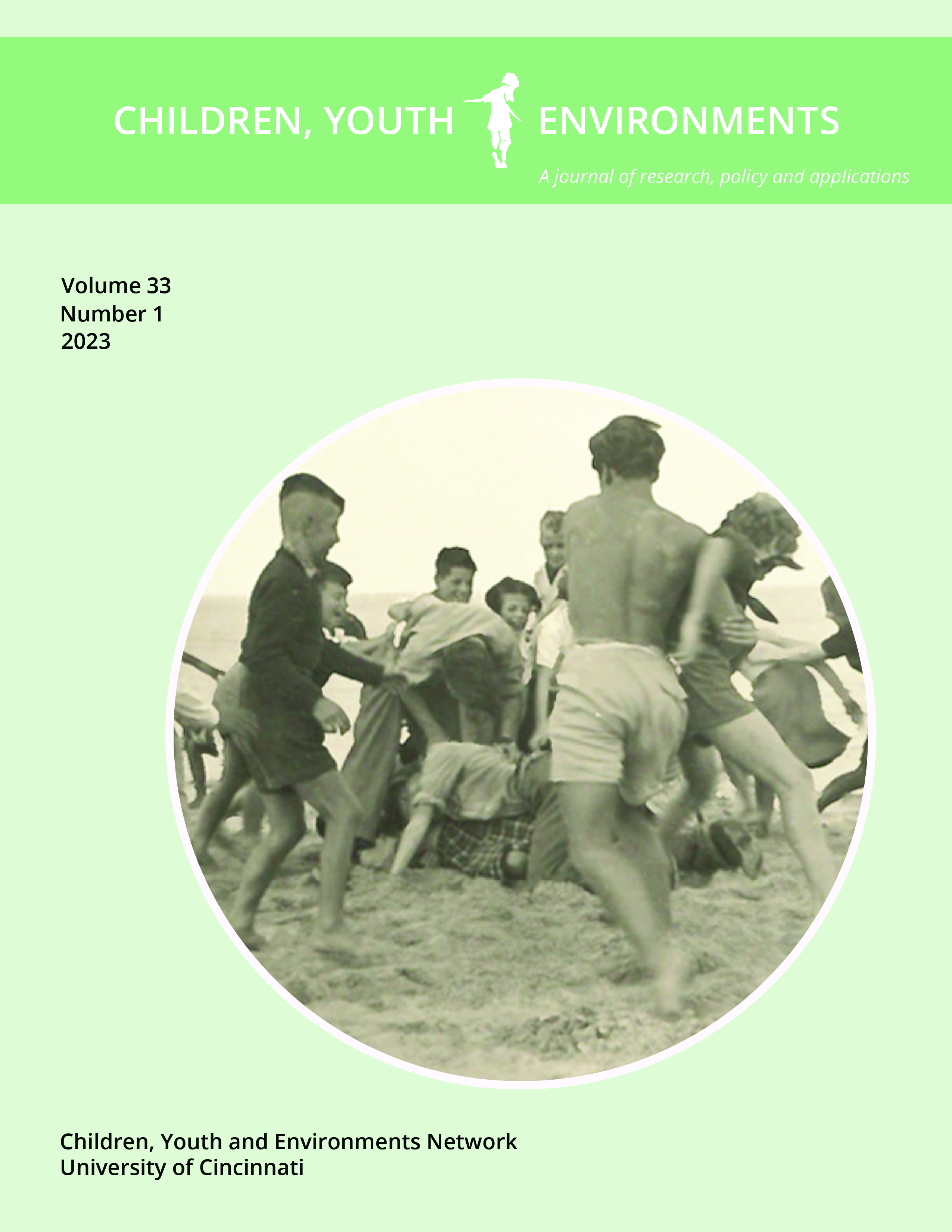
Children, Youth and Environments
Vol. 33 No. 1 (2023)Inside this issue, you will find diverse scholarly work spanning across the globe. We start our trip in Istanbul where Ataol and co-authors studied online artwork elicitations of children to reveal young people’s value as social agents in urban planning and their role in fighting against the continuous challenges our planet faces. Ataol and co-authors also demonstrate that children’s participation better in forms when children guide knowledge generation. Crossing the globe, we arrive in Toronto where Souza Donato and co-authors examine how neighborhood landscape affordances relate to children’s play during COVID-19. Findings suggest the greater number of landscape characteristics and the higher the population density is related to decreased time spent outdoors. Additionally, children who had access to
trails within their neighborhoods were more likely to spend time outdoors during the pandemic. Moving south, we arrive in the midwestern United States where Altenburger conducted an ethnographic case study examining how building design focused on engagement and safety is used to also support school practices. Ultimately, findings revealed that the educational environment that prioritizes students’ containment to secure sufficient attendance rates leaves the teenagers feeling betrayed and untrusted.
Heading across the Atlantic Ocean, we arrive in Scotland where Rae and co-authors looked at the relationship between school environment and identity development to reveal access to social places relates to social identity. Next, we arrive in Sweden, where Almers and co-authors address how primary school children’s perspectives on a ‘good schoolyard’ can be illuminated through envisioning workshops using model-making and explain ways to best engage children
through this type of research. Heading to the southern hemisphere, we arrive in Australia where Miller and co-authors investigated the distribution and use of purpose-built nature play spaces to reveal their prevalence and suggest most South Australian schools have facilities to provide nature-based play and learning. We end our world tour in Brazil where Silva and Iared studied children’s sensory responses to green areas around their school to reveal interesting and rich ways urban contexts can be used to spark interest in environmental education. The issue continues with a historical note by van Vilet– detailing the emergence of ‘Hedenesse,’ a self-governing youth village in West Zeeuws-Flanders, The Netherlands, after World War II. This is followed by a report from the field. Dillon and co-authors share their project focusing on outdoor gardening in early childhood education in the United Arab
Emirates. We close our issue with Bergamini’s review of Earthquake Children: Building Resilience from the Ruins of Tokyo, by Janet Borland. Happy Reading! -
Children, Youth and Environments
Vol. 32 No. 3 (2022)As we publish our second special issue on COVID-19, many are optimistic that the pandemic is nearing an end.However, as we asserted in our first issue, the real longitudinal impacts of COVID-19 on children, youth, and society are unknown. Current and future waves of infections caused by coronavirus variants and sub-variants make clear that the pandemic is not yet over; the virus will continue to naturally progress. Yet, as CYE goes to press, the World Health Organization is considering whether the pandemic is still an international public health emergency and governments are seeking ways to provide new bivalent vaccines to all its citizens and streamline its COVID-19 guidelines to accelerate a return to normal life activities. Travel has resumed, increasing the potential for contracting COVID-19, schools are in session face-to-face with virtual forms of education that may be enduring, and workers are negotiating new approaches to fulfilling their job duties. Yet, worldwide effects on children and youth are evident as reported across our two special issues and within others’ research and the public media. Bronfenbrenner’s (1979) ecological systems theory with its concentric circles of complex relationships visibly frames the impact of the pandemic --from government mandates to the closing of businesses and schools, to family health care and financial struggles, to children’s play, learning, and life experiences. Articles in this special issue focus on how activities for children and youth had to yield to those impacts -changing venues, utilizing virtual media, and altering transportation modes. This issue also provides insight into family and youth perspectives on caregiving and pandemic-related socio-ecological contexts.
Inside this issue, you will find diverse scholarly work that spans across the globe focusing on the impacts of COVID-19 where children live, learn, and play. We first we head to Europe where Percy-Smith and coauthors sought to understand how the pandemic brought about new opportunities in terms of young people’s personal development, social actorship and political agency, in spite of its detrimental impacts across sevendifferent countries. Next, we make our way across the Atlantic and arrive in Canada where Larouche and coauthors assessed parent-perceived changes in active transportation and independent mobility among 5-to 17-year-olds since the outbreak of COVID-19 through twonation-wide surveys. We then wander south to the United States where Li and coauthors describe the implementation of a multiplatform science learning program that was originally developed for an in-person, formal learning environment and describe modifications made to the program based on infrastructure, preparations, and resource availability to meet the needs of distance learning in formal and informal learning environments due to COVID-19. Staying in the States, Izenstark and Sharaievskaexamined fathers’ perceptions on how their children’s outdoor recreation changed during COVID-19, and differences between rural and urban participants’ outdoor experiences to reveal that due to sweeping lifestyle changes, fathers reported increased time spent outdoors and the development of new outdoor family routines as a way to promote children’s health, fulfill caretaking responsibilities, and promote family relationships. Additionally, urban fathers reported more outdoor restrictions due to local policies whereas rural fathers reported engaging in a larger variety of nearby outdoor activities.
Richmond and coauthors examined how COVID-19 affected the summer activities and environments of children from high-and low-income homes in the United States toshow that youth from high-income homes had access to more enriching activities both before and during the pandemic, even though COVID-19 restricted access to programming for all youth. The authors also identified how work-from-home arrangements and virtual programming that arose during the pandemic could help bridge the opportunity gap moving forward. Ending our tour, we arrive in Illinois where Owens and Adkins explore the intentional design and building process of a camp community in an online program for six programs when that format was not the organizations’ original delivery mode and revealed distinct components that comprise a camp-specific community with pertinent considerations for youth development organizations seeking to create a feeling of community in their online programs. We wrap this issue with a field report from Huber and coauthors who describe and discuss their experiences with Playgroup at Home LIVE, a group of children (birth-5 years) and their parents who meet regularly to play and socialize the transitioned to virtual meetings during COVID-19. Happy reading!
-
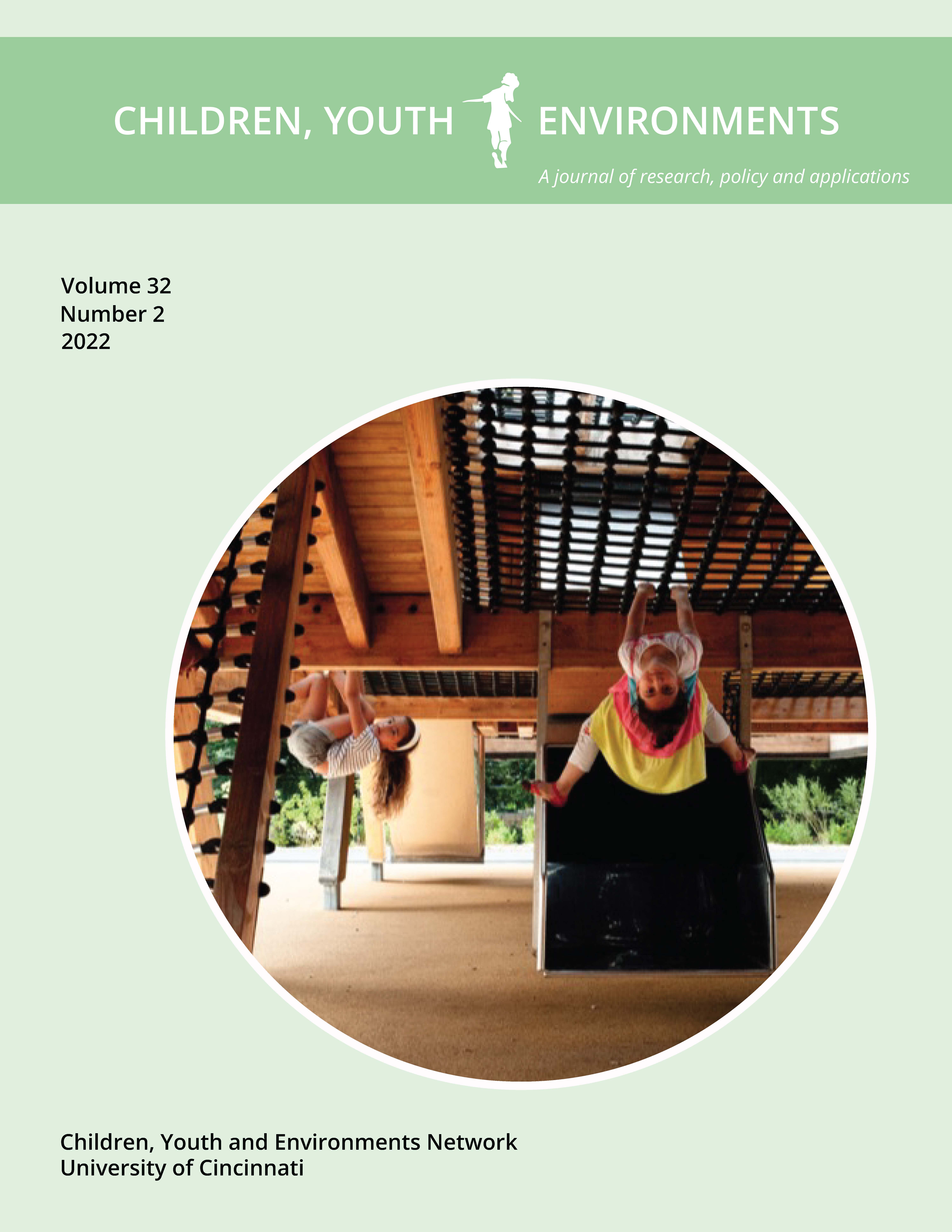
Children, Youth and Environment
Vol. 32 No. 2 (2022)Inside this issue, you will find diverse scholarly work that spans across the globe. We first stop in Vancouver where Hutton and coauthors analyzed interview data with children ages 10–13 to identify seven design principles for urban public landscapes thatsupport play for tweens. Next, we make our way across the Atlantic and arrive in the Netherlands where van Tol and coauthors investigated 11-and 12-year old’s nature connectedness to reveal that although children enjoy being in nature, they lack emotional affection toward the natural world and possess human-centric images of nature. We then head west, back to North America, to California where Dahl and Cushing revealed that garden-based pedagogies had significant, positive impacts on fourth graders’ environmental literacy, especially pro-environmental awareness, attitude and behavior. Hopping over to Texas, Hite and White examined Hispanic fourth and fifth grade students’ knowledge, understanding, and agency throughout a year-long after-school club on endangered marine species and oceanic conservation to reveal knowledge gains and reported perceptions of agency. Heading north, we arrive back in Vancouver where Bauer and coauthors explored how natural environments shaped the experiences of 10–13-year-olds and influenced their development of microcultures to develop two overarching themes: (1) children played in natural environments to which they had sentimental attachments; and (2) children developed microcultures away from adults. For our last stop on our global adventure, we head to the southern hemisphere and arrive in Australia. Here, Green examines youth, ages 9–17 years, perspectives about transition and climate change adaptation in regional Gippsland, Victoria to reveal four main themes: (1) youth values, (2) perceptions of energy, transition and adaptation, (3) the enabling role of climate literacy for youth; and (4) responding to a just transition through collective endeavors. We continue with The Place of Children: Poverty and Promise, a paper in which van Vliet--reviews a project from 2008-09 that raised awareness of the challenges faced by children among the urban poor worldwide and recognized their contributions to their families and communities. In the paper, van Vliet--provides updates on those who participated in the ethnographic fieldwork. This issue also includes a report from the field where Beeth and coauthors share their experience with an instructional activity that engaged preservice elementary teachers in understanding the natural world through phenology –directed observation of the natural world that builds conscious awareness of and connections with a natural area. We wrap this issue with two book reviews: Yeo’s review of Public Space Readeredited by Miodrag Mitrašinović and Vikas Mehta, and Chawla’s review of Schools That Heal: Design with Mental Health in Mindby Claire Latané. Happy reading!
Once again, we would like to remind our readers that we are delighted to announce that Children Youth and Environments has signed a new deal with University of Cincinnati Press (https://ucincinnatipress.uc.edu). Our backlist will continue to be available through JSTOR. The University of Cincinnati Press is committed to publishing rigorous, peer-reviewed, leading scholarship accessibly tostimulate dialog between the academy, public intellectuals and lay practitioners. The Press works with authors and editors to erase disciplinary to address common problems in our global community.UC Press looks for projects across the humanities, social sciences and STEM fields focusing on social justice and community engagement.
-
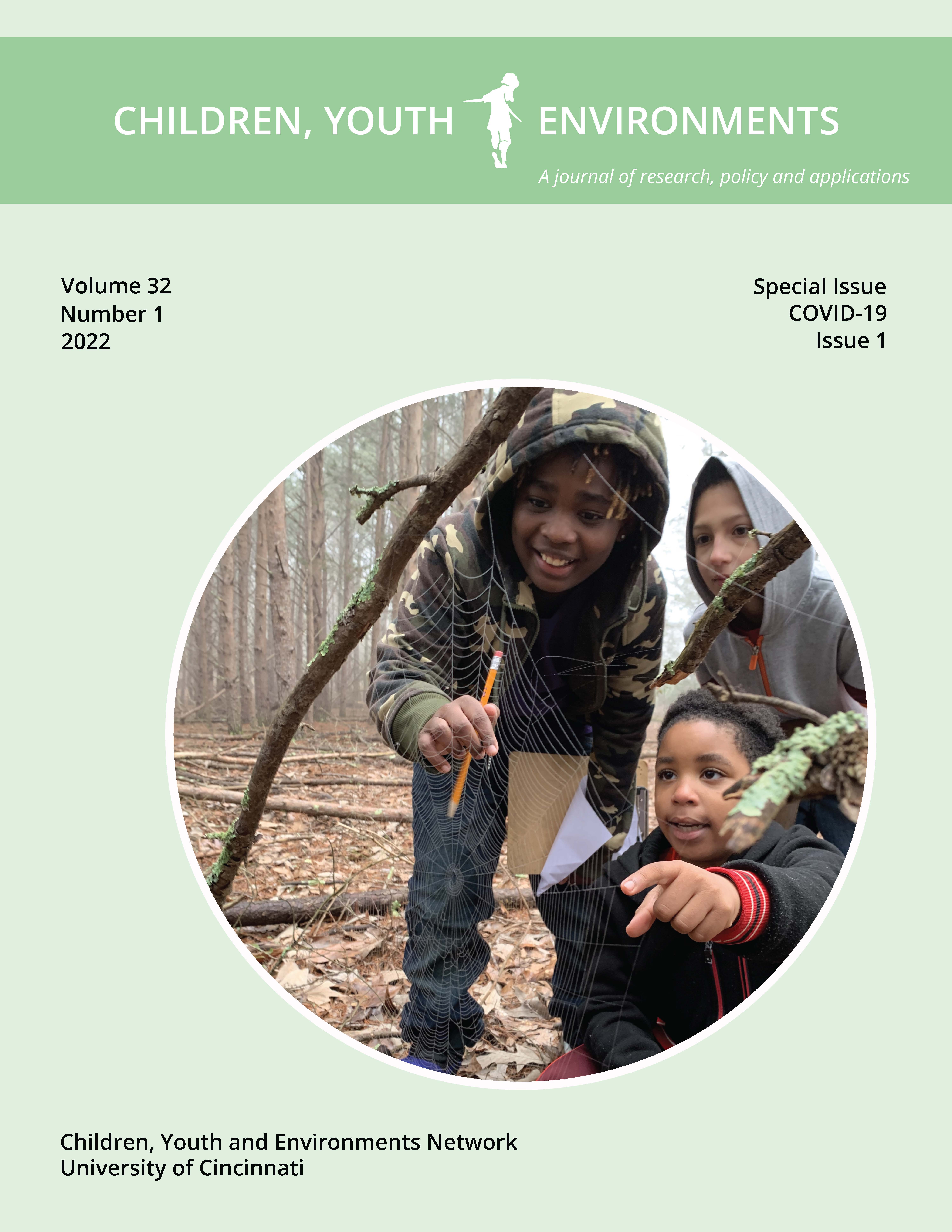
Vol. 32 No. 1 (2022)
Inside this first of two special issues on COVID-19, you will find an array of research article, field reports, a media review and a position paper that span across the globe. These articles, field reports and position paper present both sides of the outcomes of the pandemic on the lives of children and youth. They present the challenges ahead regarding learning, mental health and overall wellbeing for the young, as well as the opportunities for finding new ways to address the same, as many have done by coping in these most difficult circumstances. DiGiacomo and coauthors present the findings from a youth participatory action research (YPAR) study that focused on the students’ learning-from-home experiences in the wake of COVID-19 state-wide school closures in Kentucky, US. Next, reporting on a rapid assessment conducted by UNICEF, Chatterjee, Jobin, and Dutta present the global impact of COVID-19 on vulnerable children in urban areas in Brazil, India and Spain, where UNICEF is actively engaged in urban programming. On the positive side, Moore, Morrissey and Jeavons, reporting the use of outdoor spaces in Melbourne, Australia, observe an increased presence of children and play activity in the local natural spaces. Similarly, de Lannoy and coauthors present the findings of a Canada-wide environmental scan of outdoor play-based child and youth projects, programs, activities and services available during the height of the pandemic (2020-2021). The article by Martz, Powell and Wee covers the various spatial restrictions for youth as a result of the lockdowns and explores how youth related with nature during this time. In the final article in this issue, Seixas and co-authors explore the impact of the drastic
reduction in tourism due to the pandemic on children’s play in an urban park in a highly touristic, commercial and increasingly gentrified neighbourhood in Lisbon, Portugal.The position paper by Bishop and co-authors—members of the Children, Youth and Environments (CYE) Working Group (WG) of the Sustainable Cities and Landscapes Research Hub of the Association of Pacific Rim Universities (APRU) that includes members from Canada, USA, Australia, and New Zealand—discusses both the positive and negative impacts of COVID-19 and identifies areas for change with impact on the lives of children and young people and their environmental experience in Canada, USA, Australia, and New Zealand. The first field report by Stinehart and co-authors showcases the nimbleness and creativity of educators in response to the pandemic. The second field report by Garratt and co-authors presents stories of therapists from the United States and the United Kingdom who provide early intervention services to infants and young children who qualify with a disability or developmental delay. The issue concludes with a media review by Catherine Rita Volpe of This Podcast Will Kill You, COVID-19, Chapter 10: Schools by Erin Welsh and Erin Allman Updyke.
-
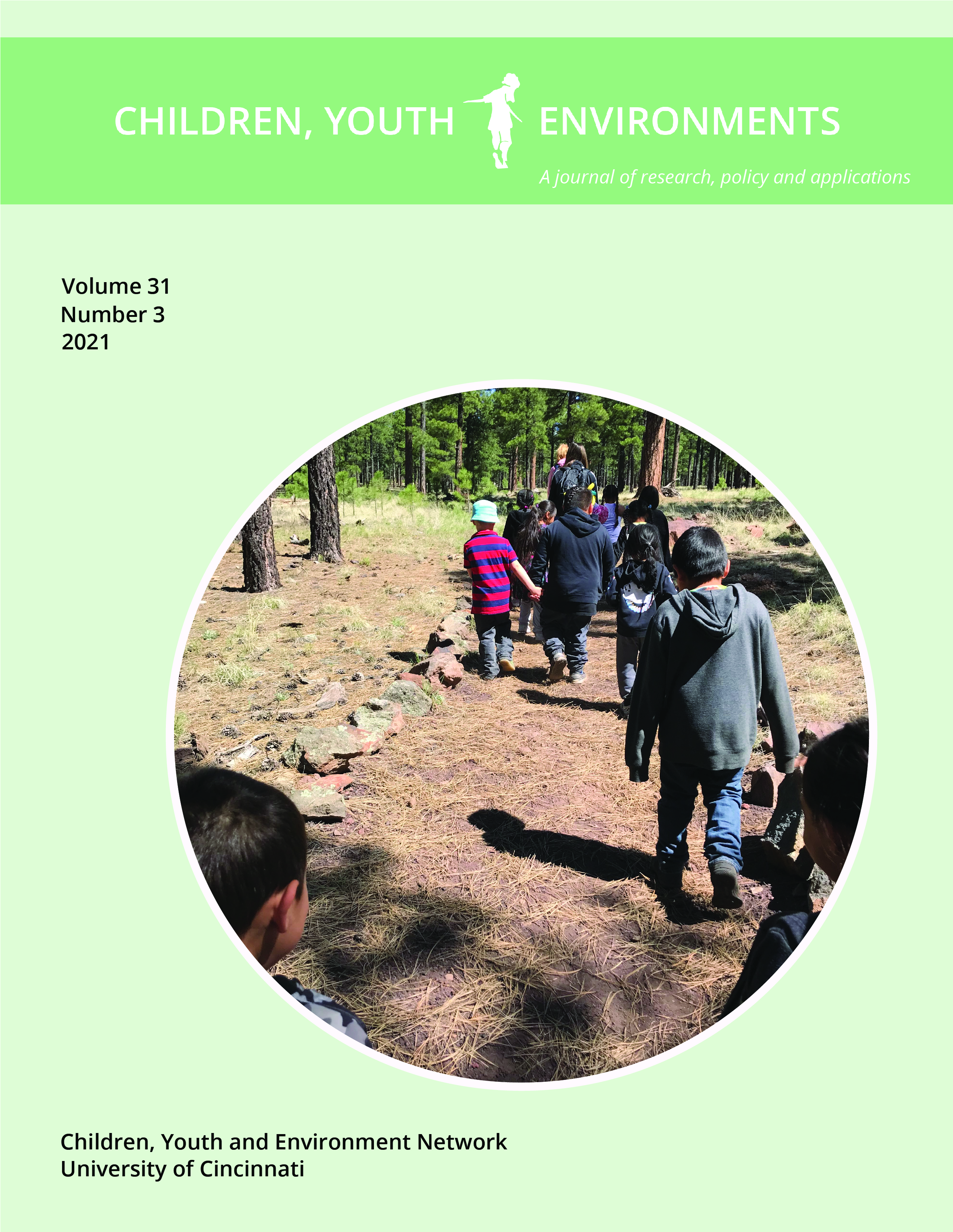
Children Youth and Environments
Vol. 31 No. 3 (2021)Inside this issue, you will find diverse scholarly work that spans across the globe. First, Schoeppich and co-authors critically review 14 studies focusing on children’s participation in playground creation to reveal gaps, inconsistencies and benefits associated with child participation. Next, we arrive in a small rural town in Upstate New York where Andrews investigated a 7-year-old girl’s conceptions of what counts as science in an everyday context. Expanding our regional focus, we visit New York state as well as, Maryland, Virginia, and Washington D.C. where Ibes and co-authors conduct intensive semi-structured interviews of local community leaders and leaders of nature-oriented organizations to enhance understanding of the barriers to nature engagement by YOC. Crossing the globe, we arrive in Iran where Manouchehri and co-authors investigated school children’s views of favorable and unfavorable attributes of their neighborhood environments. Heading South, we arrive in Porto Alegre in Brazil where Rosa and co-authors interviewed healthcare experts to identify interventions that would respond to children's needs, and architecture and mental health experts assessed their potential to improve children’s PWB to reveal that the hospital environment may stimulate all components of PWB, especially environmental mastery, personal growth, and self-acceptance. At our final stop, we head back the United States where Pic and Han explored peer conflict among preschoolers during indoor and outdoor free play in a nature-based preschool to reveal that outdoor nature environment seems to provide children more meaningful conflict situations around play ideas rather than the mere possession of material. A position paper by Gecker and co-authors helps us with understanding youth civic engagement in the aftermath of a mass shooting in Parkland. The issue continues with three reports from the field. First, Burnett and Edgeley describe ways to overcome barriers to outdoor education. Next, Tarr o describes the interactions between children and pocket parks. Then, Gravil and co-authors describe the use of citizen science and technology to connect preschool classrooms at two universitybased programs. We wrap this issue with two book reviews: Chawla’s review of The Necessity of Urban Green Space for Children’s Optimal Development: A Discussion Paper by Suchitra Sugar, and Maclure’s review of The Youngest Citizens: Children’s Rights in Latin America, by Amy Risley. Happy reading!
-
Children Youth and Environments
Vol. 31 No. 2 (2021) -
Children Youth and Environments
Vol. 31 No. 1 (2021) -
Children Youth and Environments
Vol. 30 No. 2 (2020) -
Children Youth and Environments
Vol. 30 No. 1 (2020) -
Children Youth and Environments
Vol. 29 No. 2 (2019) -
Children Youth and Environments
Vol. 29 No. 1 (2019) -
Children Youth and Environments
Vol. 28 No. 2 (2018) -
Children Youth and Environments
Vol. 28 No. 1 (2018) -
Children, Youth and Environments
Vol. 27 No. 3 (2017) -
Children, Youth and Environments
Vol. 27 No. 2 (2017)Natural Spaces and Development
-
Children, Youth and Environments
Vol. 27 No. 1 (2017) -
Children, Youth and Environments
Vol. 26 No. 2 (2016) -
Children, Youth and Environments
Vol. 26 No. 1 (2016) -
Children, Youth and Environments
Vol. 25 No. 3 (2015) -
Children, Youth and Environments
Vol. 25 No. 2 (2015)Child-Friendly Cities: Critical Approaches

